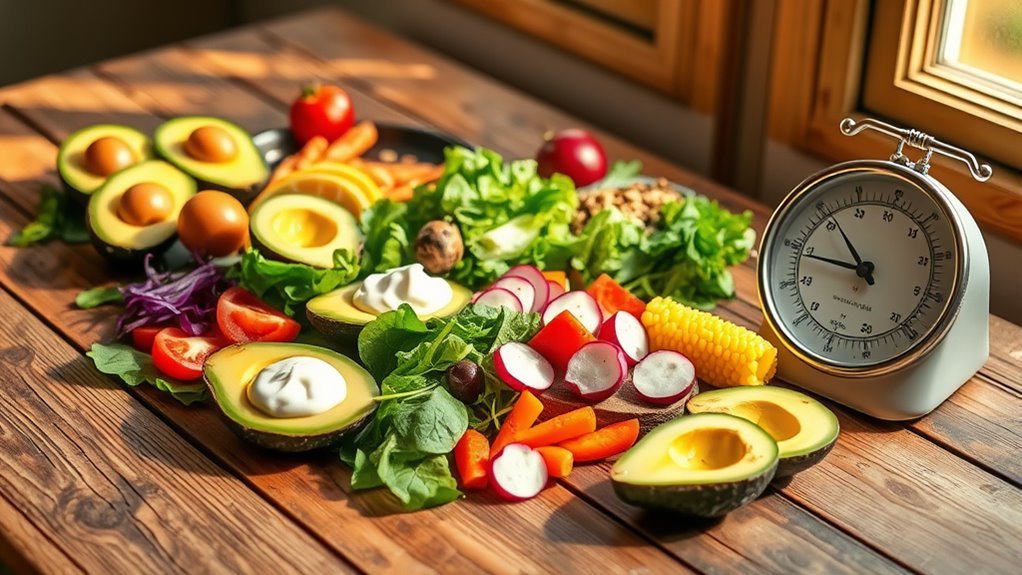In a keto diet, you should aim for a daily carbohydrate intake of 20 to 50 grams of net carbs to effectively enter and maintain ketosis. This lower carb limit encourages your body to burn fat for energy instead of carbohydrates, promoting weight loss and improved mental clarity. Individual factors like activity level and metabolic health can influence your ideal carb amount. There’s much more to discover about optimizing your keto journey and avoiding common pitfalls.
Understanding Ketosis and Its Importance

When you commence on a ketogenic diet, understanding ketosis is essential for achieving your health goals. Ketosis is a metabolic state where your body shifts from burning carbohydrates to utilizing fat for energy. This change can lead to significant ketosis benefits, including weight loss, improved mental clarity, and enhanced energy levels. By lowering your carbohydrate intake, your body produces ketones from fat, providing an efficient fuel source. Embracing this metabolic state can empower you to break free from sugar cravings and achieve more stable energy throughout the day. Additionally, ketosis may support better blood sugar control and reduce inflammation, contributing to overall health. Understanding these mechanisms equips you to navigate your ketogenic journey with confidence and purpose.
Recommended Daily Carb Intake for Keto

When following a keto diet, it’s essential to understand the recommended daily carb intake to maintain ketosis. Typically, this ideal range falls between 20 to 50 grams of net carbs, which accounts for fiber and sugar alcohols. You’ll also need to adjust your carb intake based on your activity level to optimize your results and overall health.
Ideal Carb Range
While individual needs may vary, the perfect carbohydrate range for a ketogenic diet typically falls between 20 to 50 grams of net carbs per day. Sticking to these perfect carb limits helps your body enter and maintain ketosis, where it burns fat for fuel instead of carbohydrates. This ideal carb intake encourages weight loss and improved energy levels without the crash often associated with high-carb diets. It’s crucial to monitor your body’s response as you adjust your carb intake, allowing you to find what works best for you. By focusing on nutrient-dense, low-carb foods, you can enjoy the freedom of a keto lifestyle while reaping the benefits of better health and wellness.
Net Carbs Explained
Understanding net carbs is vital for anyone following a ketogenic diet. Net carbs refer to the total carbohydrates in a food minus its fiber content, as fiber doesn’t greatly impact blood sugar levels. To achieve your keto goals, you’ll want to focus on your net carb calculation, which typically should be around 20 to 50 grams per day. This approach allows you to enjoy nutrient-dense foods without exceeding your carb limits. Remember, the fiber impact is important—high-fiber foods like vegetables and nuts can help you feel full while keeping your net carbs low. By prioritizing net carbs, you can maintain ketosis and experience the freedom that comes with a well-planned ketogenic lifestyle.
Adjusting for Activity
Adjusting your carb intake based on your activity level is key to optimizing your ketogenic diet. Higher activity levels may require you to make carb adjustments to maintain energy without disrupting ketosis. Here’s a quick guide to help you determine your daily carb intake based on your activity levels:
| Activity Level | Recommended Daily Carbs |
|---|---|
| Sedentary (little to no exercise) | 20-30g |
| Light activity (walking, casual sports) | 30-40g |
| Moderate activity (intense workouts) | 40-60g |
| High activity (athletes, heavy lifting) | 60-80g |
| Extreme activity (endurance training) | 80-100g |
Individual Factors Influencing Carb Limits

When determining your carbohydrate limits on a keto diet, several individual factors come into play, including age, activity level, metabolic health, and specific weight loss goals. Your personal health profile, including any underlying conditions, can impact how your body processes carbs. For instance, younger individuals or those with higher metabolic rates may tolerate a slightly higher carb intake while still maintaining ketosis. Conversely, if you’re less active, your body may require stricter carb limits to achieve your goals. It’s crucial to understand that these factors are interconnected; optimizing your carb intake can lead to better energy levels and more effective weight loss. By considering these individual elements, you can create a sustainable approach to your keto journey that respects your unique needs.
Tracking Your Carb Intake Effectively
To successfully navigate your keto journey, effectively tracking your carb intake is key. Carb counting helps you stay within your daily limits, ensuring you maintain ketosis. Start by choosing reliable tracking tools, like mobile apps or spreadsheets, that simplify the process. These tools can log your meals and provide nutritional breakdowns, making it easier to monitor your carbohydrate consumption.
Don’t forget to read food labels carefully, as hidden sugars can sneak in and disrupt your progress. By tracking your intake consistently, you’ll gain insight into your eating habits and make adjustments as needed. Embrace this method as a way to enhance your dietary freedom, allowing you to enjoy a variety of low-carb foods while staying committed to your goals.
Common Mistakes to Avoid on Keto
While embracing a keto diet can lead to significant health benefits, there are several common mistakes that can derail your progress. One major pitfall is falling for keto misconceptions, like thinking all fats are good or that you can ignore carb counting. It’s essential to track your carbohydrate intake diligently; exceeding your limit can kick you out of ketosis. Additionally, some people neglect to incorporate enough nutrient-dense foods, relying too heavily on processed keto snacks. This can lead to nutrient deficiencies and hinder your results. Finally, be wary of not drinking enough water, as dehydration can occur on a low-carb diet. By avoiding these mistakes, you can maximize the freedom and benefits that a keto lifestyle offers.
Delicious Low-Carb Foods to Include
Incorporating a variety of delicious low-carb foods into your diet not only makes meals enjoyable but also guarantees you’re getting essential nutrients. Focus on nutrient-dense options like leafy greens, cruciferous vegetables, and healthy fats such as avocados and olive oil. For protein, consider grass-fed meats, eggs, and fatty fish, which are all excellent choices. When you’re looking for low carb snacks, try cheese, nuts, or homemade veggie chips to satisfy cravings without compromising your goals. You can also explore keto friendly recipes that feature ingredients like cauliflower rice or zucchini noodles, providing flavorful alternatives to traditional carbs. By embracing these foods, you’ll find joy in your keto journey while fueling your body effectively.
Tips for Staying Committed to Your Keto Journey
Staying committed to your keto journey can be challenging, especially when faced with tempting high-carb options. To maintain your focus, incorporate motivation techniques that resonate with you. Visual reminders of your goals, like progress photos or inspirational quotes, can ignite your drive. Meal planning is essential; by preparing low-carb meals in advance, you’ll reduce the likelihood of impulsive choices. Stock your kitchen with keto-friendly snacks to curb cravings, and explore new recipes to keep your meals exciting. Surround yourself with supportive communities, whether online or in-person, to share experiences and challenges. Remember, it’s about progress, not perfection. Embrace this journey, and you’ll find the freedom and energy you’re seeking while enjoying delicious, satisfying foods.


